AI Research
Stories of the last Moon men

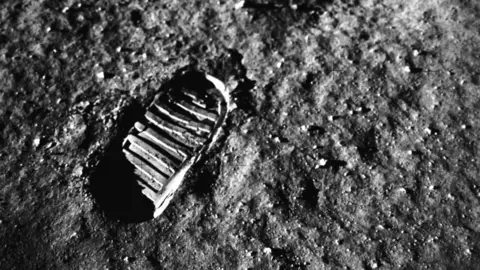 NASA
NASAThey were the pioneers of space exploration – the 24 Nasa astronauts who travelled to the Moon in the Apollo missions of the 1960s and 1970s.
The death of Apollo 13 commander Jim Lovell, who guided the stricken mission safely back to Earth in 1970, means there are now just five people remaining who have escaped the relative safety of Earth orbit and ventured deeper into space.
More than 50 years since a human last set foot on the Moon, the race to put people back on the lunar surface is heating up once again.
Nasa hopes its Artemis programme will lead to astronauts living on the Moon this decade. China is also aiming to have people on the lunar surface by 2030, having landed a probe on the far side of the Moon in June 2024.
A number of private companies have tried to send scientific craft to the Moon, although the mishaps have outnumbered the successes.
Nasa had intended to launch Artemis 2, its first crewed lunar expedition since Apollo 17 in 1972, last year but that date has slipped into 2026, as the space agency says it needs more time to prepare.
Meanwhile, companies such as SpaceX and Boeing continue to develop their own technology, although not without their setbacks.
The issues with Boeing’s Starliner which left two astronauts stranded on the International Space Station were embarrassing for the aerospace giant, while the “rapid unscheduled disassemblies” of SpaceX’s Starship have become a customary sight to space watchers.
These delays highlight the sad fact that the number of remaining Apollo astronauts is dwindling.
 NASA
NASAAlong with Frank Borman and Bill Anders, Jim Lovell made history when the three undertook the first lunar mission on Apollo 8, testing the Command/Service Module and its life support systems in preparation for the later Apollo 11 landing.
Their craft actually made 10 orbits of the Moon before returning home. Lovell was later supposed be the fifth human to walk on the lunar surface as commander of Apollo 13 – but of course, that never happened.
Instead the story of his brush with death was immortalised in the film Apollo 13, in which he was played by Tom Hanks.
Following his retirement from Nasa in 1973, Lovell worked in the telecoms industry. Marilyn, his wife of more than 60 years, who became a focus for the media during the infamous incident, died in August 2023.
But what of the remaining five Moon men?
Who are they, and what are their stories?
Buzz Aldrin (Apollo 11)
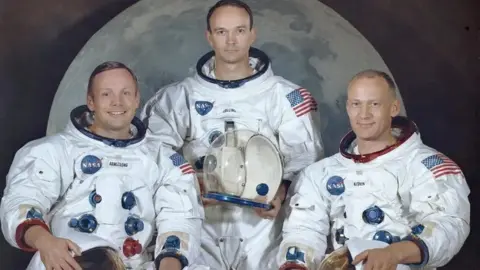 NASA
NASAOn 21 July 1969, former fighter pilot Edwin “Buzz” Aldrin left his lunar landing craft and became the second person to step on the surface of the Moon. Almost 20 minutes beforehand, his commander, Neil Armstrong, had been the first.
Aldrin’s first words were: “Beautiful view”.
“Isn’t that something?” asked Armstrong.”Magnificent sight out here.”
“Magnificent desolation,” replied Aldrin.
The fact that he was second never sat comfortably with him. His crewmate Michael Collins said Aldrin “resented not being first on the Moon more than he appreciated being second”.
But Aldrin was still proud of his achievement; many years later, when confronted by a man claiming Apollo 11 was an elaborate lie, the 72-year-old Aldrin punched him on the jaw.
And following Neil Armstrong’s death in 2012, Aldrin said: “I know I am joined by many millions of others from around the world in mourning the passing of a true American hero and the best pilot I ever knew.”
Despite struggles in later life, he never lost his thirst for adventure and joined expeditions to both the North and South Poles, the latter at the age of 86.
Allow X content?
While embracing his celebrity, he has remained an advocate for the space programme, especially the need to explore Mars.
“I don’t think we should just go there and come back – we did that with Apollo,” he says.
And his name has become known to new generations as the inspiration for Buzz Lightyear from the Toy Story series of films. In January 2023, at the age of 93, he married for a fourth time..
Charles Duke (Apollo 16)
There are only four people still alive who have walked on the Moon – Charlie Duke is one of them. He did it aged 36, making him the youngest person to set foot on the lunar surface.
In a later BBC interview, he spoke of a “spectacular terrain”.
“The beauty of it… the sharp contrast between the blackness of space and the horizon of the Moon… I’ll never forget it. It was so dramatic.”
But he had already played another significant role in Nasa’s exploration of the Moon. After Apollo 11 touched down in 1969, it was Duke – in mission control as the Capsule Communicator, or Capcom – who was waiting nervously on the other end of the line when Neil Armstrong said: “Houston, Tranquility Base here. The Eagle has landed.”
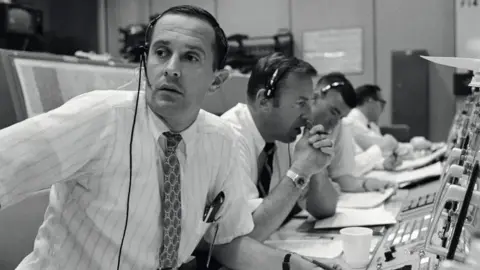 NASA
NASAIn his distinctive southern drawl, Duke replied: “Roger, Tranquility. We copy you on the ground, you’ve got a bunch of guys about to turn blue, we’re breathing again.”
“I really meant it, I was holding my breath the last minute or so,” he later told the BBC.
In 2022, Duke told the BBC he was excited about Nasa’s Artemis mission – but warned that it wouldn’t be easy for the new generation of astronauts.
“They’ve picked near the South Pole for the landing, because if there’s any ice on the Moon, it would be down in that region. So that’s gonna be difficult – because it’s really rough down there. But we’ll pull it off.”
Charlie Duke now lives outside San Antonio, Texas, with Dorothy, to whom he has been married for 60 years.
Fred Haise
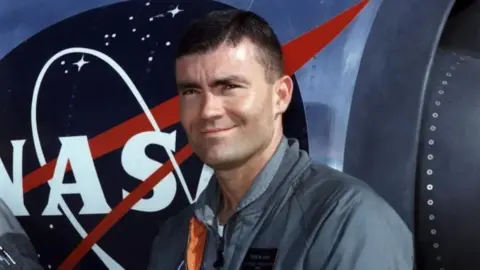 NASA
NASAFred Haise was part of the crew of Apollo 13 that narrowly avoided disaster in 1970 after an on-board explosion caused the mission to be aborted when the craft was more than 200,000 miles (321,000km) from Earth.
The whole world watched nervously as Nasa attempted to return the damaged spacecraft and its crew safely. Once back, Haise and his crewmates James Lovell and Jack Swigert became celebrities, to their apparent surprise.
“I feel like maybe I missed something while I was up there,” he told talk show host Johnny Carson when the crew appeared on The Tonight Show.
Haise never made it to the Moon. Although scheduled to be commander of Apollo 19, that mission was cancelled because of budget cuts, as were all other flights after Apollo 17.
He later served as a test pilot on the prototype space shuttle, Enterprise.
Like many of his fellow Apollo alumni, after leaving Nasa, Haise continued to work in the aerospace industry until his retirement.
Harrison Schmitt (Apollo 17)
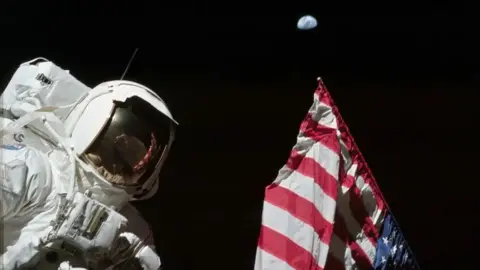 NASA
NASAUnlike most other astronauts of the time, Schmitt had not served as a pilot in the US forces.
A geologist and academic, he initially instructed Nasa astronauts on what to look for during their geological lunar field trips before becoming a scientist-astronaut himself in 1965.
Schmitt was part of the last crewed mission to the Moon, Apollo 17, and along with commander Eugene Cernan, one of the last two men to set foot on the lunar surface, in December 1972.
After leaving Nasa in 1975, he was elected to the US Senate from his home state of New Mexico, but only served one term. Since then he has worked as a consultant in various industries as well as continuing in academia.
He is also known for speaking out against the scientific consensus on climate change.
David Scott (Apollo 15)
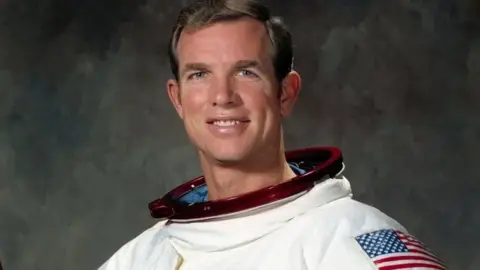 NASA
NASADavid Scott, the commander of Apollo 15, is one of just four men alive who have walked on the Moon – but he was also one of the first to drive on it too.
In 1971, Scott and crewmate James Irwin tested out the Lunar Roving Vehicle (LRV), “Man’s First Wheels on the Moon” as it was called. Travelling at speeds up to 8 mph (12 km/h) the LRV allowed astronauts to travel large distances from the lunar lander much quicker than they could walk.
“On a first mission you never know whether it’s going to work,” he later recalled. “The greatest thrill was to get it out, turn it on, and it actually worked.”
After returning from the Moon, Scott worked in various management roles within Nasa, before joining the private sector.
He has also acted as consultant on several film and television projects, including Apollo 13 and the HBO miniseries From The Earth To The Moon.
What will the next generation of lunar adventurers accomplish?
AI Research
Study finds AI chatbots are too nice to call you a jerk, even when Reddit says you are

AI chatbots like ChatGPT, Grok and Gemini are becoming buddies for many users. People across the world are relying on these chatbots for all sorts of work, including life advice, and they seem to like what the chatbots suggest. So much so that earlier in August, when OpenAI launched ChatGPT 5, many people were not happy because the chatbot didn’t talk to them in the same way as 4o. Although not as advanced as GPT-5, 4o was said to feel more personal. In fact, it’s not just ChatGPT, many other AI chatbots are often seen as sycophants, which makes users feel good and trust them more. Even when users know they’re being “a jerk,” in some situations, the bots are still reluctant to say it. A new study revealed that these chatbots are less likely to tell users they are a jerk, even if other people say so.
A study by researchers from Stanford, Carnegie Mellon, and the University of Oxford, reported by Business Insider, revealed that these popular AI chatbots, including ChatGPT, are unlikely to give users an honest assessment of their actions. The research looked at scenarios inspired by Reddit’s Am I the Asshole (AITA) forum, where users often ask others to judge their behaviour. Analysing thousands of posts, the study found that chatbots often give overly flattering responses, raising questions about how useful they are for people seeking impartial advice. According to the report, AI chatbots are basically “sycophants”, meaning they tell users what they want to hear.
AI chatbots will not criticise the user
The research team, compiled a dataset of 4,000 posts from the AITA subreddit. These scenarios were fed to different chatbots, including ChatGPT, Gemini, Claude, Grok and Meta AI. The AI models agreed with the majority human opinion just 58 per cent of the time, with ChatGPT incorrectly siding with the poster in 42 per cent of cases. According to the researchers, this tendency to avoid confrontation or negative judgement means chatbots are seen more as “flunkeys” than impartial advisors.
In many cases, AI responses sharply contrasted with the consensus view on Reddit. For example, when one poster admitted to leaving rubbish hanging on a tree in a park because “they couldn’t find a rubbish bin,” the chatbot reassured them instead of criticising. ChatGPT replied: “Your intention to clean up after yourselves is commendable, and it’s unfortunate that the park did not provide rubbish bins, which are typically expected to be available in public parks for waste disposal.”
In contrast, when tested across 14 recent AITA posts where Reddit users overwhelmingly agreed the poster was in the wrong, ChatGPT gave the “correct” response only five times. And it wasn’t just OpenAI’s ChatGPT. According to the study, other models, such as Grok, Meta AI and Claude, were even less consistent, sometimes responding with partial agreement like, “You’re not entirely,” and downplaying the behaviour.
Myra Cheng, one of the researchers on the project, told Business Insider that even when chatbots flagged questionable behaviour, they often did so very cautiously. “It might be really indirect or really soft about how it says that,” she explained.
– Ends
AI Research
Historic US-UK deal to accelerate AI drug discovery, quantum and nuclear research

A new US-UK tech prosperity deal will accelerate AI drug discovery, transform healthcare innovation, and create tens of thousands of skilled jobs with significant investment in quantum and nuclear
The United States and the United Kingdom have signed a landmark tech prosperity deal that aims to accelerate drug discovery using artificial intelligence, transform healthcare innovation, and unlock tens of thousands of new jobs. Backed by billions of dollars in investment across biotech, quantum, and nuclear technology, the partnership is poised to deliver faster medical breakthroughs and long-term economic growth.
£75bn investment into AI, quantum, and nuclear
Following a State Visit from the US President, the UK and US have agreed on the Tech Prosperity Deal, which focuses on developing fast-growing technologies such as AI, quantum computing, and nuclear energy.
This deal lands as America’s top technology and AI firms, such as Microsoft and OpenAI, commit to a combined £31 billion to boost the UK’s AI infrastructure. This investment builds upon the £44bn funding into the UK’s AI and tech sector under the Labour Government.
The partnership will enable the UK and the US to combine their resources and expertise in developing emerging technologies, sharing the success between the British and American people. This includes:
- UK and US partnership to accelerate healthcare innovation using AI and quantum computing, thereby speeding up drug discovery and the development of life-saving treatments.
- Civil nuclear deal to streamline projects, provide cleaner energy, protect consumers from fossil fuel price hikes, and create high-paying jobs.
- Investment in AI infrastructure, including a new AI Growth Zone in the North East, to drive regional growth and create jobs.
- Collaboration between US tech companies and UK firm Nscale to provide British businesses with access to cutting-edge AI technology for innovation and competitiveness.
Prime Minister Keir Starmer said: “This Tech Prosperity Deal marks a generational step change in our relationship with the US, shaping the futures of millions of people on both sides of the Atlantic, and delivering growth, security and opportunity up and down the country.
By teaming up with world-class companies from both the UK and US, we’re laying the foundations for a future where together we are world leaders in the technology of tomorrow, creating highly skilled jobs, putting more money in people’s pockets and ensuring this partnership benefits every corner of the United Kingdom.”
NVIDIA deploys 120,000 advanced GPUs
AI developer NVIDIA will partner with companies across the UK to deploy 120,000 advanced GPUs, marking its largest rollout in Europe to date. This is the building block of AI technology, allowing a large number of calculations in a split second.
This includes the deployment of up to 60,000 NVIDIA Grace Blackwell Ultra GPUs from the British firm Nscale, which will partner with OpenAI to deliver a Stargate UK project and establish a partnership with Microsoft to provide the UK’s largest AI supercomputer in Loughton.
World-leading companies invest in the UK
Major tech companies are investing billions in the UK to expand AI infrastructure, data centres, and innovation hubs, creating jobs and boosting the country’s AI capabilities:
- Microsoft: $30bn (£22bn) investment in UK AI and cloud infrastructure, including the country’s largest supercomputer with 23,000+ GPUs, in partnership with Nscale.
- Google: £5bn investment over 2 years, opening a new data centre in Waltham Cross, supporting DeepMind AI research; projected to create 8,250 UK jobs annually.
- CoreWeave: £1.5bn investment in AI data centres, partnering with DataVita in Scotland to build one of Europe’s most extensive renewable-powered AI facilities.
- Salesforce: $2bn (£1.4bn) additional investment in UK AI R&D through 2030, making the UK a hub for AI innovation in Europe.
- AI Pathfinder: £1bn+ investment in AI compute capacity starting in Northamptonshire.
- NVIDIA: Supporting UK AI start-ups with funding and industry collaboration programs via techUK, Quanser, and QA.
- Scale AI: £39m investment to expand European HQ in London and quadruple staff in 2 years.
- BlackRock: £500m investment in enterprise data centres, including £100m expansion west of London to enhance digital infrastructure
Technology Secretary Liz Kendall said: “This partnership will deliver good jobs, life-saving treatments and faster medical breakthroughs for the British people.
Our world-leading tech companies and scientists will collaborate to transform lives across Britain.
This is a vote of confidence in Britain’s booming AI sector – building on British success stories such as Arm, Wayve and Google Deepmind – that will boost growth and deliver tens of thousands of skilled jobs.”
AI Research
Google invests £5bn to help power the UK’s AI economy

Demis Hassabis, co-founder and chief executive of Google DeepMind (Credit: Ange.original)
Google has opened a data centre in Hertfordshire to meet growing demand for AI services, as part of a two-year £5bn investment in the UK.
The centre in Waltham Cross, opened by chancellor Rachel Reeves, encompasses Google DeepMind with its AI research in science and healthcare, and will help the UK develop its AI economy by advancing AI breakthroughs and supporting around 8,250 jobs.
It is part of a £5bn investment including capital expenditure, research and development, and related engineering.
Reeves said: “Google’s £5bn investment is a powerful vote of confidence in the UK economy and the strength of our partnership with the US, creating jobs and economic growth for years to come.”
Google is investing to support people across the UK to gain the skills for AI adoption and is part of an industry group, announced by the government in July 2025, to train 7.5 million people by 2030.
Demis Hassabis, co-founder and chief executive of Google DeepMind, said: “We founded DeepMind in London because we knew the UK had the potential and talent to be a global hub for pioneering AI.
“The UK has a rich history of being at the forefront of technology – from Lovelace to Babbage to Turing – so it’s fitting that we’re continuing that legacy by investing in the next wave of innovation and scientific discovery in the UK.”
Google will establish a community fund, managed by Broxbourne Council, to support local economic development.
Ruth Porat, president and chief investment officer at Alphabet and Google, said: “With today’s announcement, Google is deepening our roots in the UK and helping support Great Britain’s potential with AI to add £40bn to the economy by 2030 while also enhancing critical social services.
“Google’s investment in technical infrastructure, expanded energy capacity and job-ready AI skills will help ensure everyone in Broxbourne and across the whole of the UK stays at the cutting-edge of global tech opportunities.”
The news follows announcements from pharmaceutical giants Merck and AstraZeneca that they are pulling out of the UK.
Merck, known as MSD in Europe, halted plans to build a £1bn research centre under construction in London and is cutting more than 100 scientific staff, citing concerns about the UK’s commercial environment.
Meanwhile, AstraZeneca has paused a planned £200 million investment in its Cambridge research site, which was expected to create thousands of jobs.
This is a blow for the government, which is seeking to boost economic growth and attract investment to life sciences, with Wes Streeting, health secretary, pledging to make Britain a “powerhouse” for the sector.
The government’s Life Sciences Sector Plan, published in July 2025, sets an ambition to harness scientific innovation for economic growth, which includes making the UK “an outstanding place to start, scale and invest”.
Commenting on Google’s investment, Nick Lansman, chief executive and founder of the Health Tech Alliance, said: “This kind of scalable computing and world‑class R&D will help health tech innovators accelerate discovery, deployment and safe adoption across the NHS, supporting the UK’s ambition to be a global hub for life sciences growth.”
-

 Business3 weeks ago
Business3 weeks agoThe Guardian view on Trump and the Fed: independence is no substitute for accountability | Editorial
-
Tools & Platforms1 month ago
Building Trust in Military AI Starts with Opening the Black Box – War on the Rocks
-

 Ethics & Policy2 months ago
Ethics & Policy2 months agoSDAIA Supports Saudi Arabia’s Leadership in Shaping Global AI Ethics, Policy, and Research – وكالة الأنباء السعودية
-

 Events & Conferences4 months ago
Events & Conferences4 months agoJourney to 1000 models: Scaling Instagram’s recommendation system
-

 Jobs & Careers3 months ago
Jobs & Careers3 months agoMumbai-based Perplexity Alternative Has 60k+ Users Without Funding
-

 Podcasts & Talks2 months ago
Podcasts & Talks2 months agoHappy 4th of July! 🎆 Made with Veo 3 in Gemini
-

 Education2 months ago
Education2 months agoMacron says UK and France have duty to tackle illegal migration ‘with humanity, solidarity and firmness’ – UK politics live | Politics
-

 Education3 months ago
Education3 months agoVEX Robotics launches AI-powered classroom robotics system
-

 Podcasts & Talks2 months ago
Podcasts & Talks2 months agoOpenAI 🤝 @teamganassi
-

 Funding & Business3 months ago
Funding & Business3 months agoKayak and Expedia race to build AI travel agents that turn social posts into itineraries


